I have no idea of the exact location of the following photo. It is one of my father’s and dates from 1949. Judging by the photos on the strips of negatives that included this photo, it is probably one of a number of Bankside alleys, although there is a chance it is a bit further east.
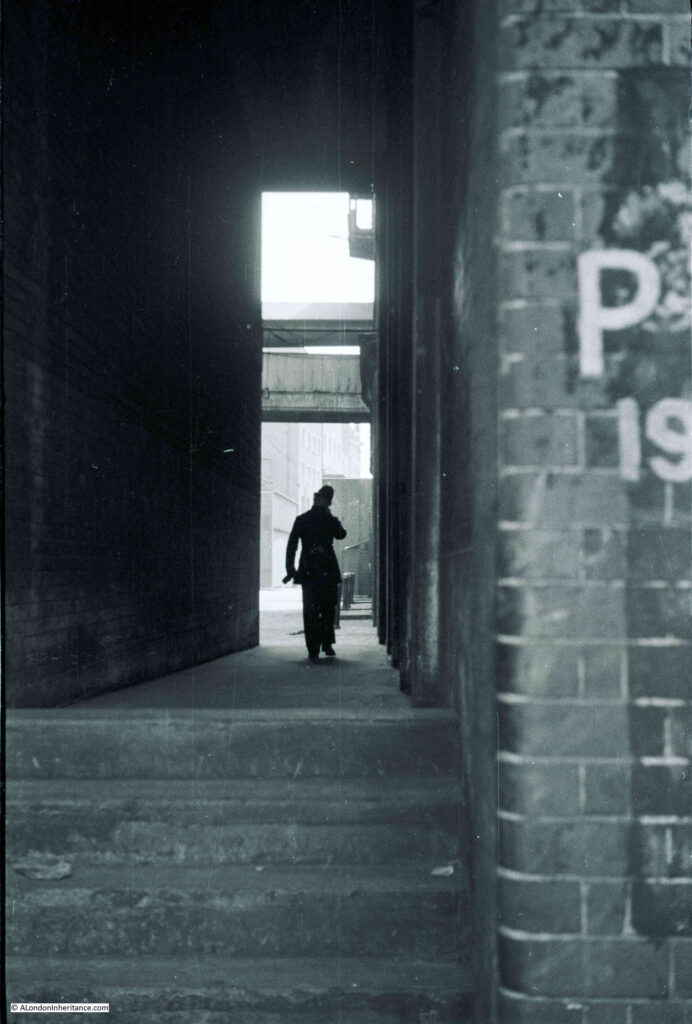
The photo shows a police officer walking through an alley, probably between warehouses. At the end of the alley, there is one of the typical walkways that were built to connect warehouses on opposite sides of a street.
I love the photo as it captures what must have been a relatively common event – a lone police officer patrolling his beat.
Policing has changed considerably in the 72 years since the photo. Budget cuts have reduced police numbers, streets now have CCTV and there is the ongoing threat of terrorism.
Along Bankside, there are no warehouses full of goods that would tempt a thieve. The river is quiet and is no longer teeming with barges and lighters, although as the tragic events on London Bridge just a week ago demonstrate, the Thames is still a very dangerous place for anyone who enters the water.
The police officer in the photo was probably on his “beat” – a set route around a district that an officer would patrol. They would get to know the streets, the people, activity that was normal, and what was not normal.
Being assigned to a beat was the first step in a police officer’s career after training and being posted to a station as a Police Constable.
In the book “Fabian of the Yard” (1950) by Superintendent Robert Fabian, he provides an introduction to the activity of “being on a beat”:
“On the beat, an officer should normally walk the regulation 2.5 m.p.h. – if he is hurrying he is probably after someone or more likely going home to his supper. Properly carried out, patrol duty is not half so dull as you might imagine. The most ordinary looking street can to the practiced eye be of absorbing interest. Each doorway, shadow at a window, hurried footstep or meaningful glance may have a tale to tell”.
(Fabian of the Yard is a fascinating account of London policing and crime between the 1920s and 1940s)
Crime was frequently reported after the event, however the benefit of being on the beat, was that anything unusual, and a possible crime, could be investigated as it happened. Detailed newspaper reporting of such events tended to reduce in the 20th century, however in the 19th century, papers were full of long accounts of crimes, often including the conversations that had taken place during an inquest, or the words of the police officers involved.
The following three extracts are examples of the type of action that a police officer on the beat would frequently get involved with, when patrolling along the river’s edge.
From the Shipping and Mercantile Gazzete on Thursday the 8th February, 1877:
“THEFT FROM A BARGE – At the Southwark Police-court, Joseph Sadler, 22, a returned convict, was charged with being concerned with two others in stealing three pieces of oak timber from a barge on the River Thames, the property of Messrs. Shuter and Co., coopers and stave merchants, Shad Thames.
George Barnett, police-sergeant 56M, said that between 10 and 11 on the previous night he was on duty in Bermondsey-wall when he saw the prisoner and two others coming from Eaton’s Wharf. They were each carrying a piece of timber and as soon as they saw him they dropped the timber and ran away. He, however, captured the prisoner, but his companions escaped. He made inquiries, and found that the timber had been stolen from a barge lying off Bermondsey-wall. Mr. William Joseph Littell, of the firm Shuter and Co., identified the three pieces of oak timber as the property of the firm. Mr. Partridge committed the prisoner for trial”.
From the St. James Chronicle, August 1855:
“SOUTHWARK. CHARGE OF BURGLARY – John Richard South, a tall young man, partially dressed in military attire, and who stated himself to belong to the Royal Artillery, was charged with being concerned with another, not in custody, with breaking in to the Watermen’s Arms public-house, Bankside.
Joseph Alley, police-constable, 30M, said he was on duty shortly before three o’clock that morning in Bankside, and when passing the Waterman’s Arms he heard something breaking inside, which induced him to stop.
Another constable then came up, when they again heard the breaking noise, and saw the reflection of a light inside. Witness immediately directed the other constable to go to the rear of the house, while he knocked on the door for admittance and rang the bell. While doing so he heard a rushing noise inside, and a minute or two afterwards, the landlord came down and opened the street door. Witness entered and passed through, when he saw two men climbing up a shed. He got up after them, and saw the prisoner concealed behind a chimney, and as he came near him he exclaimed ‘It’s all right, I’ll give myself up’. He took the prisoner into custody, but his companion made his escape”.
From the Morning Post, 2nd July 1833:
“Yesterday two men, named Morrett and Yates, were brought before Mr. Murray, charged on suspicion of drowning a young woman (name unknown), whose body was taken out of the water at Bankside.
A police sergeant of the M division on proceeding over Blackfriars Bridge on Sunday morning, about four o’clock, saw some persons looking through the balustrades, and heard them exclaim ‘That a woman was in the water’. He looked in the direction of Southwark bridge, and perceiving a splashing in the water at some distance off, he ran round to Bankside, and by the time he arrived saw the body of a young female just brought on shore by a waterman.
He observed two men standing upon a barge moored at some distance out in the river, and he had been informed that these two men were with this female at the time she was drowned. Acting upon this intelligence he procured a wherry, and immediately went on board the barge, and took them both into custody.
The accused were examined separately, and Yates made the following statement voluntarily;- he said that he and the other prisoner were brass founders, and worked at a large factory in St Martin’s-lane. On Saturday night after work, they went to the Cart and Horses in Upper St Martin’s-lane which they left at half past eleven o’clock, and then went home together, but did not retire to rest.
At three o’clock in the morning they left home together with the determination of taking an excursion on the water. On their way to Westminster bridge they met a young female near the Horse Guards, and they spoke to her, and told her they were going to have a pull down the river. She expressed her desire to accompany them; they endeavoured to dissuade her, but when they hired the boat, which was at Mr Lyons, near the bridge, she said she was determined to go with them, and accordingly jumped into the boat along with them.
They then proceeded down the rive, the tide running that way, and in the course of their progress, run against a chain or warp to which a barge was made fast. This was about midway between the two bridges, and in an attempt to extricate it the wherry heeled over and the female rolled into the river. One of them (Yates) got hold of the barge and saved himself, and rescued Morrett, who was on the point of being drowned, and would inevitably have shared the fate of the female had not Yates grasped him by the collar and pulled him on board the barge.
in reply to the Magistrate the accused said he never saw the deceased before; that she appeared to be 18 years of age, and that they were unacquainted with who or what she was. She was dressed in a dark half-mourning dress, and wore a straw bonnet with ribands. The other prisoner gave a similar account of the transaction, and they were ordered to be detained in custody, as there were some mysterious circumstances attending the case”.
The following day an inquest was held and a verdict of accidental death was returned. Much of the critiscm at the inquest seems to have fallen on two other parties, not the two men found on the barge.
When the young woman’s body was first found, “two medical men” had been called, but had refused to attend. One of their assistants only arrived an hour later.
The proprietor of the boat was criticised for “letting out a wherry at that hour in the morning without some experienced person to attend to it; and that it was in consequence of this neglect that many casualties occurred in the river”. A deodand of £5 was levied on the boat. A deodand was a forfeit on an object where it has caused, or been involved with, a person’s death.
A scene that a police officer on the beat may have been interested in is shown in the following photo from the same strip of negatives, so around the same bankside area.
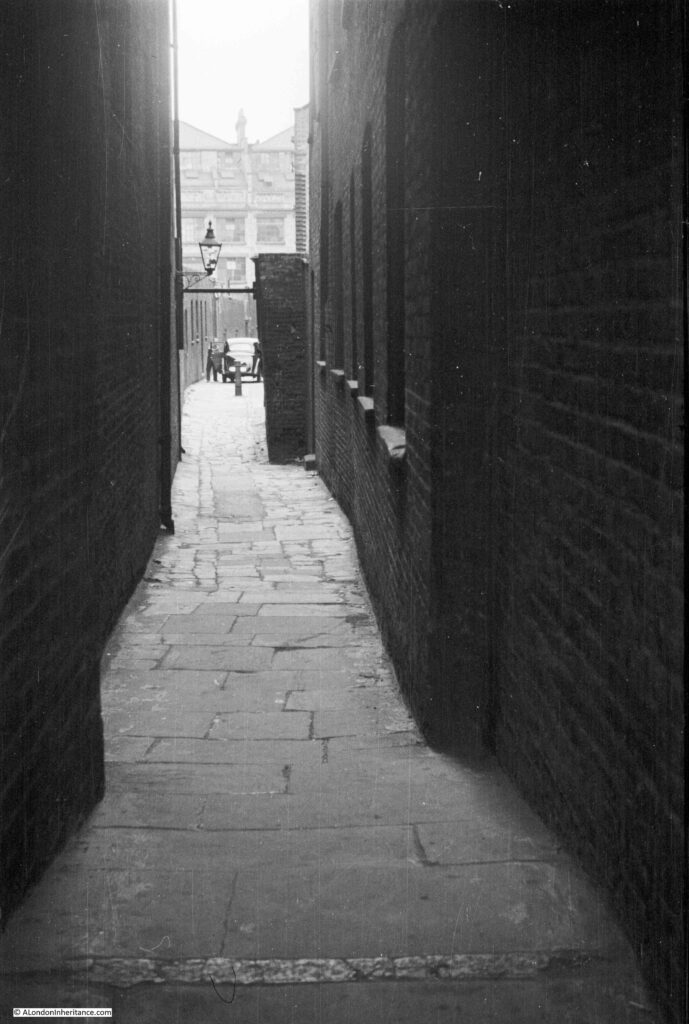
A quiet alley and some activity around a car in the distance.
Again, I cannot identify the location of the alley, there are no features that enable identification, and the area has changed so much in the last 72 years that as far as I can tell, the alley has long disappeared.
A glance at the 1896 edition of the Ordnance Survey map shows the number of alleys that were once along Bankside (‘Reproduced with the permission of the National Library of Scotland’).
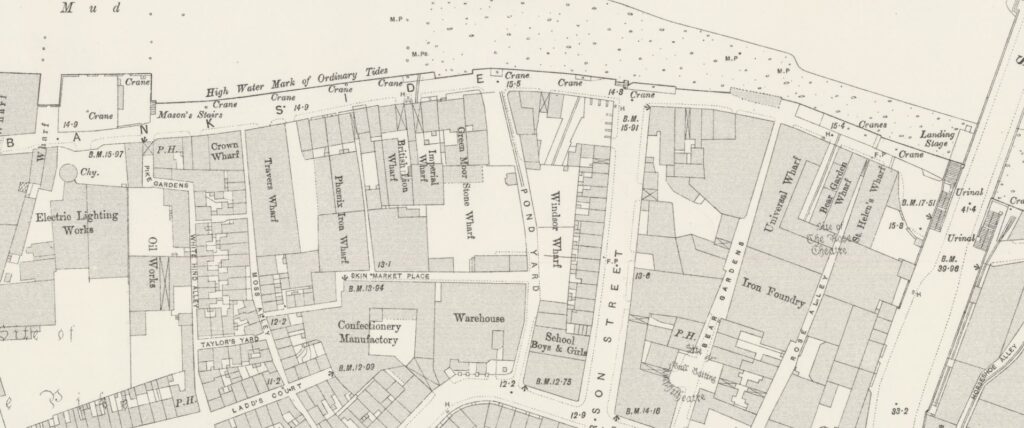
In the above extract, Tate Modern now occupies the area on the left, and Southwark Bridge is on the right.
From left to right there is: Pike Gardens, leading to White Hind Alley, Moss Alley and Rose Alley, along with narrow streets leading up to the Thames such as Pond Yard and Bear Gardens.
These alleys have now dissapeard when you walk along the Thames, however there are traces further in land, such as Rose Alley, which is now a short stretch of narrow street acting as a service road to the building that now blocks the end of the old alley to the Thames.
There is one alley part remaining, although this is not named on the above map.
Underneath the letter I of the word Bankside (running along the street on the Thames embankment), there is a narrow alley with no name. This is Cardinal Cap Alley, with the entrance being found between two buildings just to the west of the Globe Theatre.
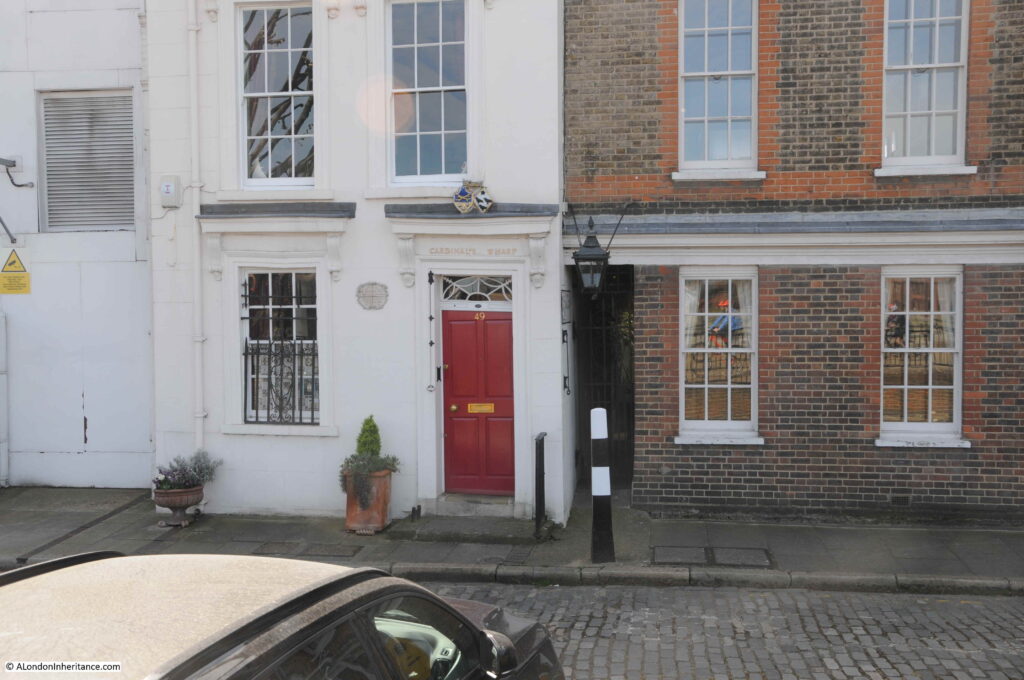
I wrote a post about Cardinal Cap Alley and No. 49 Bankside back in 2015 as the alley and number 49 have a fascinating history.
The alley has been controversially gated off for some years, however looking through the bars of the gate we can see the remains of an old Bankside alley.
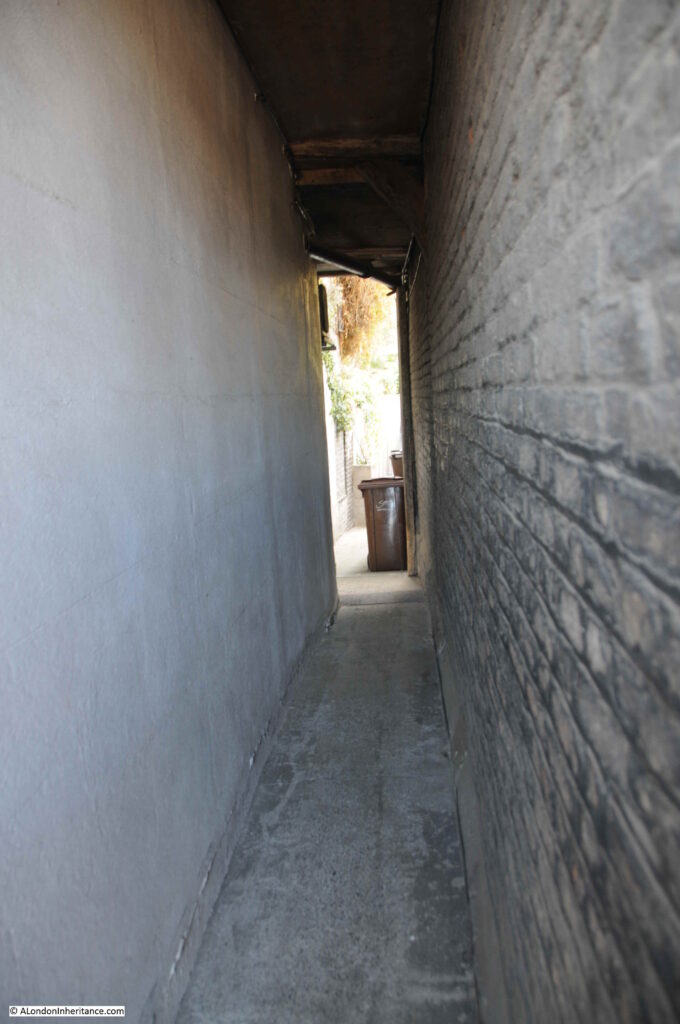
Cardinal Cap Alley was open in the 1970s, and the view across to St Paul’s was one of my early photographic attempts, with my first camera, a Kodak Instamatic 126 (although the camera did not handle contrast that well, so St Paul’s is only just visible across the river).
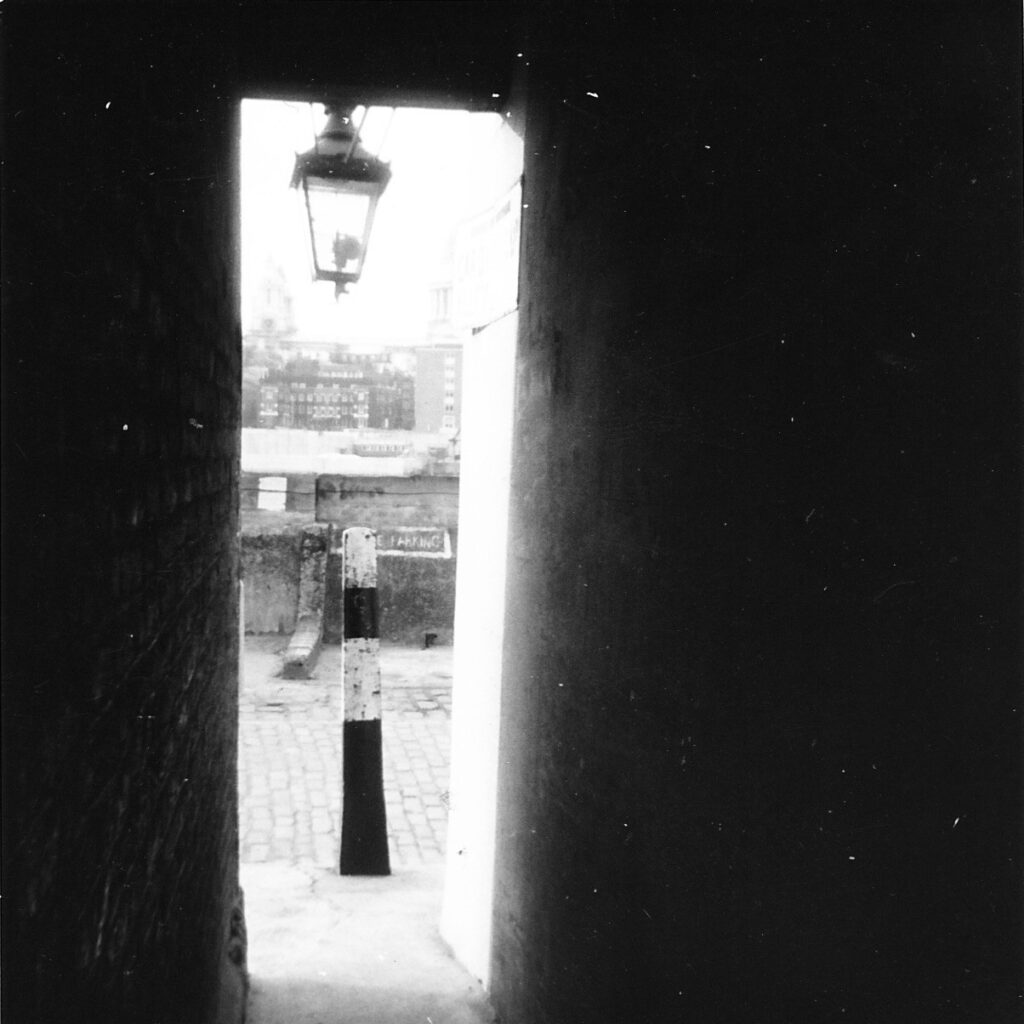
I have no idea whether the police officer in my father’s 1949 photo was walking the regulation 2.5 mph, or as Fabian of the Yard also suggested that he may be hurrying home for his supper.
The policing of the river and the land along the river’s edge has changed considerably in the 72 years since the photo was taken, and the majority of Bankside alleys have been replaced with new buildings facing onto the Thames. Both Bankside and the river are today a very different place.

Lovely photographs. Bankside is such an interesting area. I have a book somewhere that was written a couple of years ago detailing the story of one of the houses there, No 49?, since the time it was first built about three hundred years ago. The police stories remind me so much of my own early years as a Constable in Hackney. Those were the days when we walked everywhere, taking in everything as we looked around. I well remember catching two young burglars as a result of a glimpse of one of them standing at the corner of an alley acting as lookout! On my second glance, he was gone. I walked into the alley and found him looking up at a window, from which his friend was leaning out and lowering the stolen property. Yessss.
I suspect the title of the book was,”The House By The Thames” by Gillian Tindall. I’ve got it as well.
Victor
Another great article on a very interesting neighbourhood. Thank you. I am currently writing an article that has a part about Bankside and I have a question. Do you know when the wall across Bankside was built?
Thanks for all your great posts.
Do you have any information on Eaton’s Wharf? I have recently found a distant ancestor who was concerned with a plantation in Jamaica in the 1880s called Eaton, formally Eton. I wondered if there might be a connection?
Victor
Yes Victor, that was the book. What a great read. S
From an early age up to 13 years of age from the mid 50s to the mid 60s Rose Alley, Bear Gardens and Cardinal Cap Alley were my playgrounds. I lived at No 1 Horseshoe Alley just east of Southwark Bridge. It’s hard to be very certain but I think that the second photograph in your article showing a car with an open door is of Rose Alley looking south towards Park Street where Oxo used to have a premises.
You can e certain that it is Rose Alley Don. The 1947/1964 OS shows the post and the distinctive shape of the remaining Alley.
Thought provoking and absorbing as always. Love the atmosphere in the old photos.
I absolutely love your father’s photos and the stories and histories that go along with them. The photo of the lone police officer patrolling his beat is heart-wrenching to me… my father born and raised in Scotland would have been a teenager when the photo was taken. My father use to tell us so many WWII stories but as a child I didn’t grasp the severity of it. I’m glad your father left some history behind (which we all now get to share)
Looking at these types of photos, I wonder if this fellow was just starting or ending his day. How long did he work as a Beat officer, what did he see on his daily journey, what was the city like just a few years after WWII, and I even wonder if he is still alive (if so he would have to be in his 90s if not older).
Thanks for sharing these wonderful photos.
A beautiful photograph. Bill Brandt took a similar shot in Bermondsey. Your picture is as evocative. Patrick Dransfield
I think the photo with the policeman is taken from Horsleydown old stairs, but river side and looking through to Horsleydown Lane. The buildings in the distance seem to still be there but there are many modern buildings on the left now. If you look at your post about Horsleydown old stairs, I think you will see what I mean. The brickwork around the entrance has now been painted over with a battleship grey but the pointing and the brick laying pattern matches. The overhead conveyors would, presumably have stretched from warehouses in Horsleydown Lane.
Hi Annie. The photo of the policeman was in fact taken from Morgan Lane Stairs looking south.
The ‘passage’, which may have been referred to as Morgans Passage or Alley, leads into Morgan’s Lane which at the southern end intersects Tooley Street Street. The dark wall seen on the right is that of the gutted ‘Wilsons Wharf’. The northern end of Morgans Lane, from where the picture was taken, would have been some 30m west of the visitors entrance we see today to the moored navy vessel ‘HMS Belfast’.
Refer to: The 1947/1964 England and Wales OS which shows the Morgans Lane basic profile.
Great Britain OS Air Photos 1944/1950. Clearer aerial images exist, taken by RAF aerial surveys.
Very evocative picture very interesting comments.
I joined the Met in 1977 and was posted to Bow Street. It was probably one of the last stations to use the beat system due to its small size and lack of vehicles. The senior P.Cs would not let you into the only car during your first 2 years. It was the best (but not necessarily the most efficient) way to learn policing. I’m glad I had that opportunity. I still live in central london and during lockdown I have walked the old manner never seeing a foot patrol. Times have changed.
Re the second photo of the alley with the car. This, I think, is taken from Emerson Place, now long gone, looking towards the Emerson Building in Emerson Street. That, with its rather distinctive windows, is still there. Shortly after the photo was taken, most of this alley was taken down and now it is covered with modern buildings.
It has been a rainy day but I really must get back to reality now…
My recent post re: Reddin’s Wharf was formally Windsor Wharf, when working there from the early 60’s I never knew of my family’s history in Bankside. There is a painting of the crane with a Reddins Wharf sign.